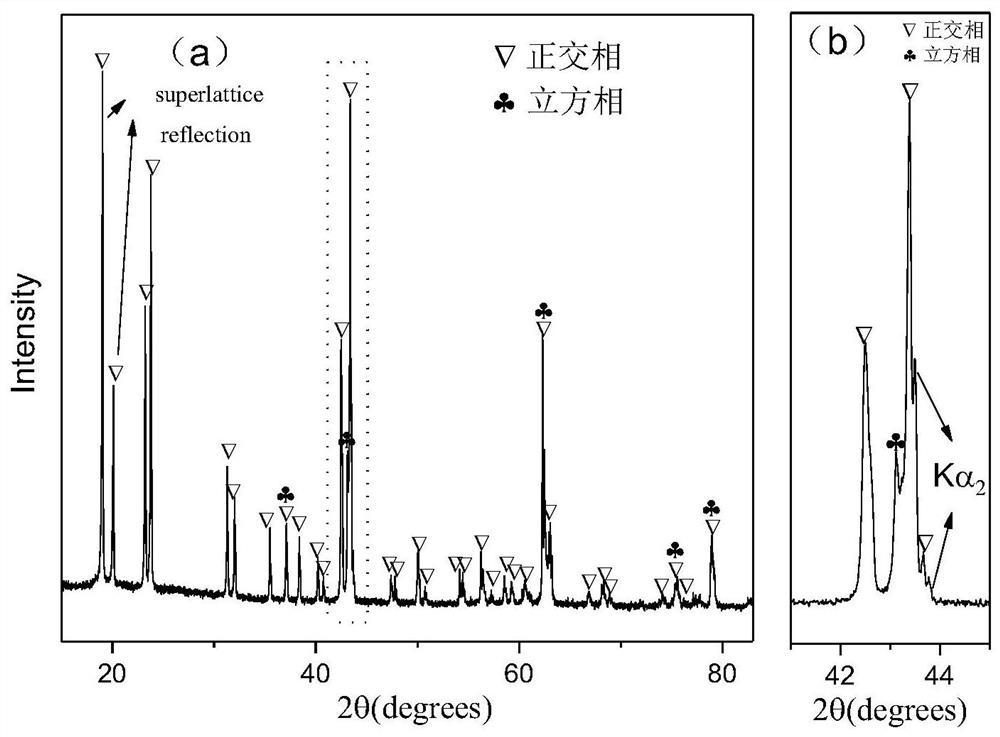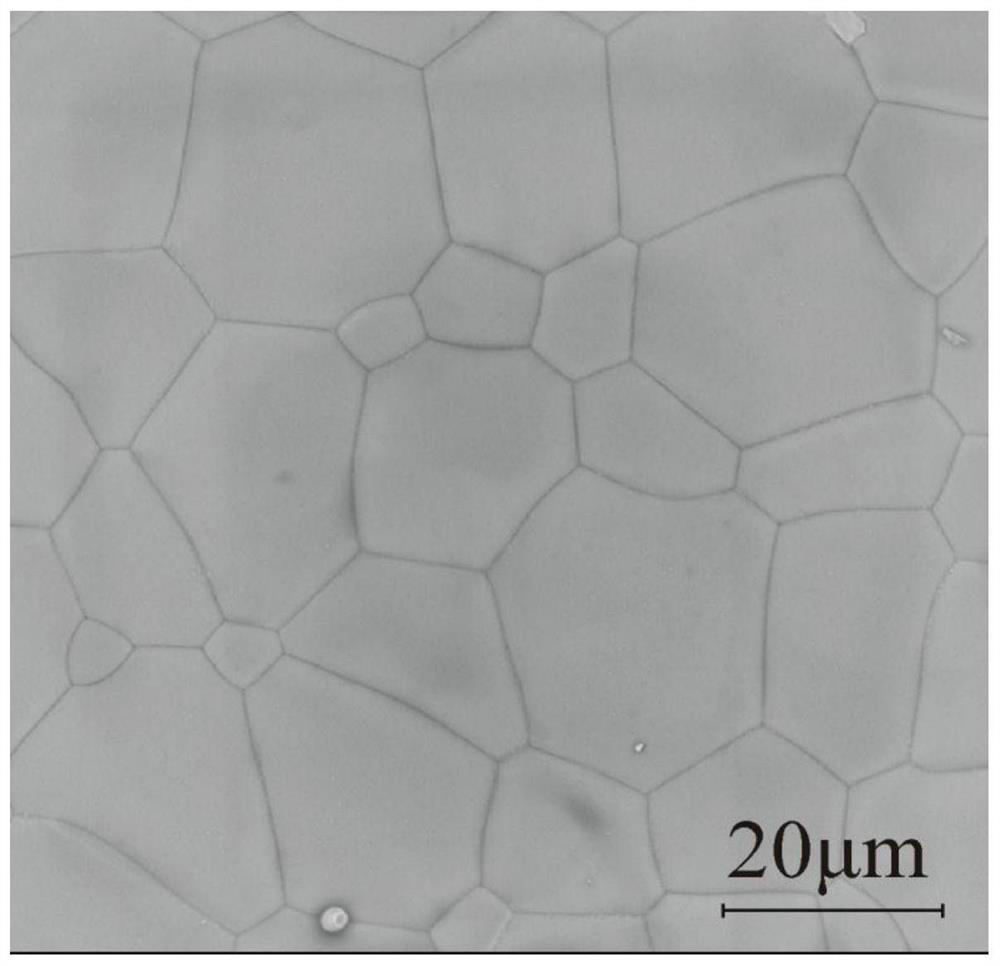Multiphase rock-salt structure ultra-low loss microwave dielectric ceramic material and preparation method thereof
A microwave dielectric ceramic and microwave ceramic technology are applied in the field of electronic information functional materials and devices, which can solve the problems of increasing dielectric loss of materials, increasing industrial production costs, and being difficult to meet industrial applications, achieving stable performance, saving time and energy costs. , the effect of increasing the complexity of the process
- Summary
- Abstract
- Description
- Claims
- Application Information
AI Technical Summary
Problems solved by technology
Method used
Image
Examples
preparation example Construction
[0034] Its preparation method comprises the following steps:
[0035] Step 1: Add basic magnesium carbonate Mg(OH) 2 4MgCO 3 ·5H 2 O, Li 2 CO 3 , rare earth oxides of Nb or Ta, oxides of titanium, tin or zirconium, according to Li 3+a Mg 2-b / 3 x 1-2b / 3 Y b+c o 6+2c The molar ratio of the general chemical formula is prepared, wherein X is Nb 5+ or Ta 5+ , Y is Ti 4+ , Sn 4+ or Zr 4+ , 0.03 ≤ a ≤ 0.12, 0.12 ≤ b ≤ 0.38, 0 ≤ c ≤ 0.15, the obtained mixture is milled with zirconia balls, and absolute ethanol is used as the solvent, according to the weight of the mixture: grinding balls: ethanol The ratio is 1:(5~7):(2~4) for grinding for 5~8 hours, and finally a uniformly mixed mixture is obtained;
[0036] Step 2: Dry the ball-milled mixture at 100°C and pass through a 60-mesh sieve to obtain a dry powder, then pre-fire and keep it warm at 900-1050°C for 3-5 hours to obtain a sample briquette;
[0037] Step 3: Pulverize the sample sintered block, do not add dopant or...
Embodiment 1
[0048] Step 1: Magnesium carbonate basic (Mg(OH) 2 4MgCO 3 ·5H 2 O), Li 2 CO 3 , Nb 2 o 5 and TiO 2 , prepare materials according to the mass ratio of 43.66%, 25.93%, 27.09% and 3.32% respectively, the resulting mixture is milled with zirconia balls, and absolute ethanol is used as a solvent. The weight ratio was 1:5:2 for grinding for 6 hours, and finally a homogeneous mixture was obtained;
[0049] Step 2: Dry the ball-milled mixture at 100°C and pass through a 60-mesh sieve to obtain a dry powder, then pre-sinter at 1000°C for 3 hours to obtain a sample briquette;
[0050] Step 3: Pulverize the sample burnt block, use zirconia balls as the ball milling medium, use dehydrated ethanol as the solvent, grind for 2 hours according to the weight ratio of mixture: balls: ethanol is 1:5:2, and dry, Granulation treatment, the size of the granulation is controlled at 120 mesh, and the granules are put into the forming mold for dry pressing to form a green body;
[0051] Step...
Embodiment 2
[0053] Step 1: Magnesium carbonate basic (Mg(OH) 2 4MgCO 3 ·5H 2 O), Li 2 CO 3 , Nb 2 o 5 and TiO 2 , prepare materials according to the mass ratio of 43.34%, 26.27%, 25.94% and 4.45% respectively, the obtained mixture is milled with zirconia balls, and absolute ethanol is used as solvent, according to the mixture: grinding ball: ethanol Grind for 7 hours at a weight ratio of 1:6:3, and finally obtain a homogeneous mixture;
[0054] Step 2: Dry the ball-milled mixture at 100°C and pass through a 60-mesh sieve to obtain a dry powder, and then pre-sinter at 900°C for 4 hours to obtain a sample briquette;
[0055] Step 3: Pulverize the sample sintered block, weigh it, add 0.8wt% ZnO dopant to the sample sintered block, use zirconia balls as the ball milling medium, and use dehydrated ethanol as the solvent, according to the mixture: grinding balls: ethanol The weight ratio was 1:6:3 and ground for 3 hours, dried and granulated, and the granulated size was controlled at 12...
PUM
| Property | Measurement | Unit |
|---|---|---|
| resonant frequency temperature coefficient | aaaaa | aaaaa |
| resonant frequency temperature coefficient | aaaaa | aaaaa |
| relative permittivity | aaaaa | aaaaa |
Abstract
Description
Claims
Application Information
 Login to View More
Login to View More - R&D
- Intellectual Property
- Life Sciences
- Materials
- Tech Scout
- Unparalleled Data Quality
- Higher Quality Content
- 60% Fewer Hallucinations
Browse by: Latest US Patents, China's latest patents, Technical Efficacy Thesaurus, Application Domain, Technology Topic, Popular Technical Reports.
© 2025 PatSnap. All rights reserved.Legal|Privacy policy|Modern Slavery Act Transparency Statement|Sitemap|About US| Contact US: help@patsnap.com



